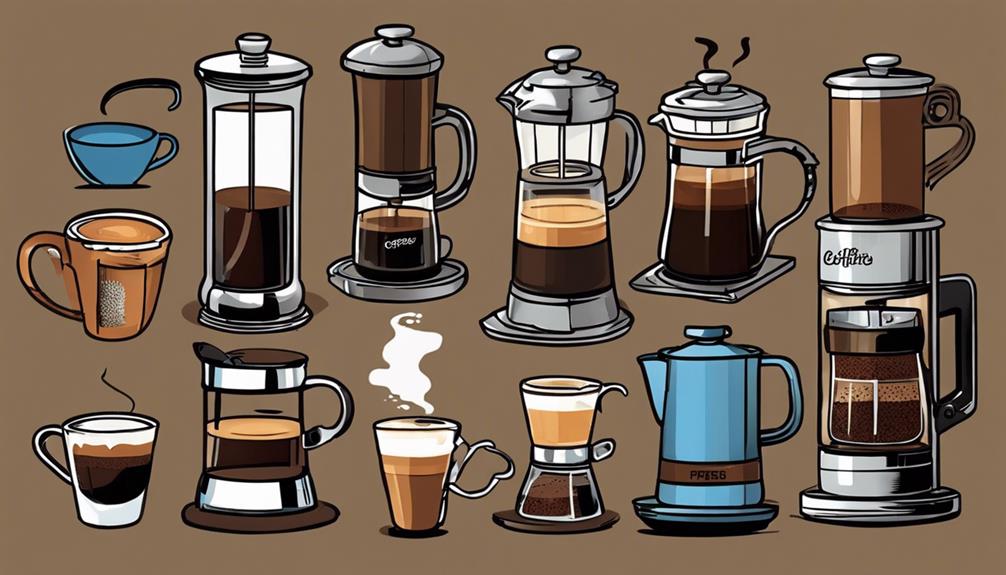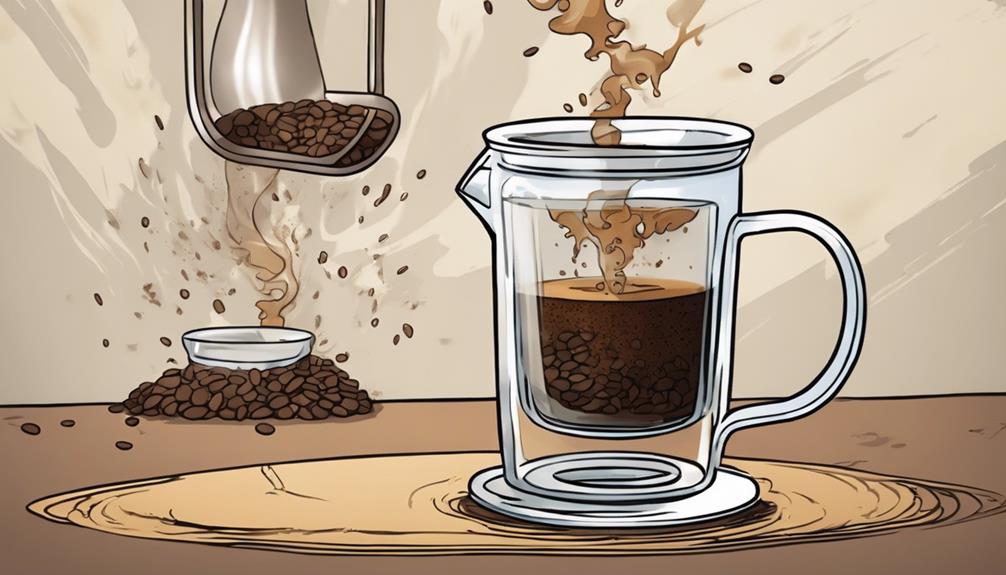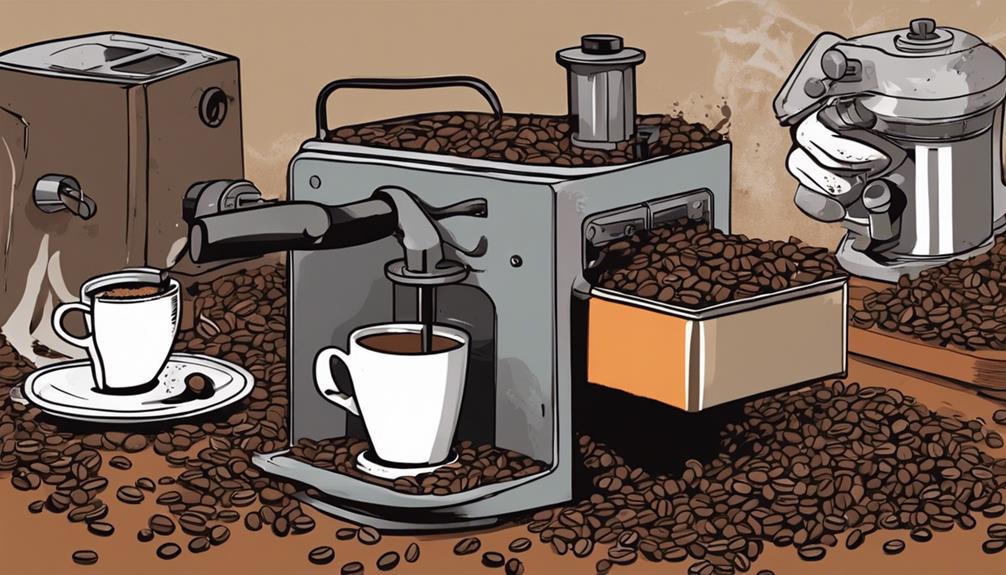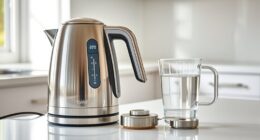When selecting the top ground coffee, it is recommended to opt for freshly ground beans in order to preserve the flavor and aroma. It is best to avoid pre-ground coffee as it can lead to flavor loss and exposure to oxygen. If you do choose pre-ground coffee, be sure to store it properly to keep it fresh. Explore different varieties such as medium roast, dark roast, flavored, and single-origin to discover what best suits your palate. Consider aspects like roast intensity, flavor characteristics, and packaging when making your choice. Enhance your coffee journey by understanding your preferences and trying out various brewing methods. Dive deeper into the world of ground coffee to elevate your coffee experience!
Key Takeaways
- Consider roast level, flavor profiles, and bean origin for personalized taste.
- Choose high-quality, freshly ground coffee for optimal flavor and aroma.
- Explore medium, dark, flavored, single-origin, and organic ground coffee options.
- Factor in packaging, freshness, and storage methods for ultimate coffee enjoyment.
- Experiment with different brewing methods to enhance the coffee experience.
Reasons to Avoid Pre-Ground Coffee
When choosing the best ground coffee, it's recommended to avoid pre-ground coffee due to its susceptibility to flavor degradation and freshness issues. Freshly ground coffee offers superior flavor and aroma due to increased surface area for extraction.
Pre-ground coffee, on the other hand, is vulnerable to environmental factors like oxygen, which can compromise its freshness. Additionally, pre-ground coffee requires proper degassing to prevent under-extraction and a stale taste. Fine-ground coffee deteriorates quicker than coarse grind varieties because of its larger surface area.
To maintain freshness, storing pre-ground coffee in vacuum-sealed, opaque containers is essential. These containers help protect the coffee from oxygen exposure, which can lead to flavor loss.
Can We Keep Pre-Ground Coffee Fresh?
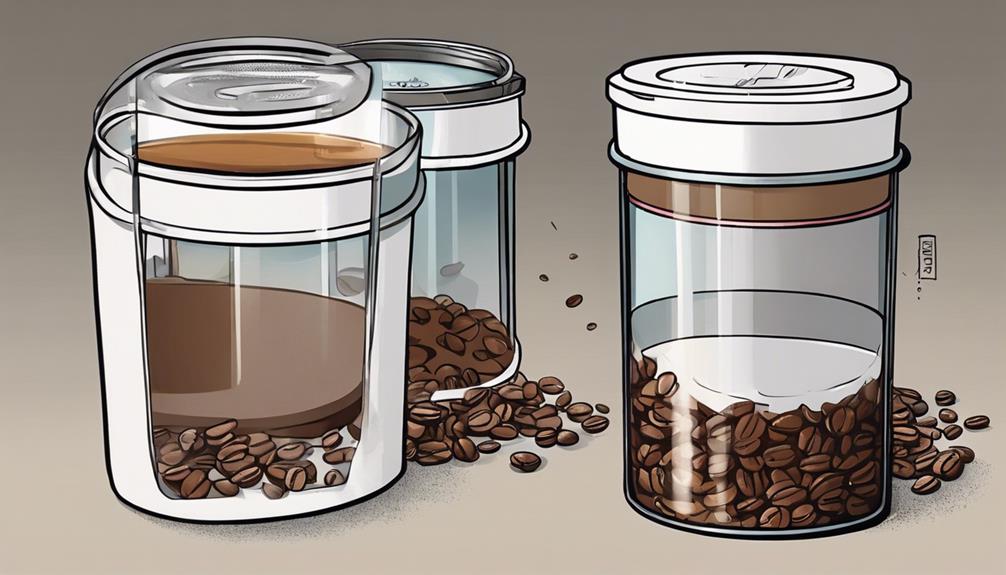
You can maintain the freshness of pre-ground coffee by storing it properly in vacuum-sealed, opaque containers.
Remember to steer clear of refrigeration as it can expose your coffee to extreme temperatures and moisture, affecting its flavor.
Freezing roasted coffee might be a viable option to help preserve the freshness of your pre-ground coffee.
Freshness Maintenance Techniques
To maintain the freshness of pre-ground coffee, proper storage techniques are essential. Ground coffee, especially finely ground, is prone to quick deterioration, making it vital to store it correctly to prevent staleness. One effective method to preserve the freshness of pre-ground coffee is through proper storage in vacuum-sealed, opaque containers. This helps minimize exposure to oxygen and light, which can degrade the quality of the coffee over time. It is important to note that storing pre-ground coffee in the fridge is not recommended due to the potential risk of moisture affecting the oils and flavors of the coffee.
| Freshness Maintenance Techniques | Benefits |
|---|---|
| Vacuum-sealed containers | Minimizes oxygen exposure |
| Opaque containers | Reduces light exposure |
| Avoiding fridge storage | Prevents moisture damage |
| Freezing roasted coffee | Effective freshness maintenance |
Properly stored pre-ground coffee can outperform poorly ground fresh coffee, making it a convenient option when a quality grinder is not available.
Pre-Ground Coffee Storage
Maintaining the freshness of pre-ground coffee is important for optimal flavor, necessitating correct storage techniques to prevent rapid deterioration. When it comes to storing pre-ground coffee, here are some key tips to help you maintain its freshness:
- Store pre-ground coffee in vacuum-sealed, opaque containers to minimize exposure to oxygen and light.
- Avoid refrigerating pre-ground coffee as temperature changes and moisture can affect its flavor.
- Consider freezing roasted coffee as a method to preserve the freshness of pre-ground coffee.
- Guarantee appropriate storage to prevent moisture from impacting the oils and flavor of your pre-ground coffee.
Freshly Ground Vs. Pre-Ground Coffee

When comparing freshly ground coffee to pre-ground coffee, the former typically offers superior flavor and aroma due to its increased surface area for extraction. Freshly ground coffee retains more of its natural oils and compounds, resulting in a more vibrant and aromatic cup of coffee.
On the other hand, pre-ground coffee is vulnerable to oxygen exposure, leading to a stale taste and aroma over time. To maintain the freshness of pre-ground coffee, proper storage techniques like vacuum-sealing and using opaque containers are essential.
Moreover, consistently ground coffee provides better control over the extraction process and flavor balance compared to inconsistently ground coffee. While freshly ground coffee tends to excel in flavor, pre-ground coffee can still be a suitable option when lacking a quality grinder or when stored properly to outperform poorly ground fresh coffee.
Ultimately, the choice between freshly ground and pre-ground coffee depends on your preferences, equipment, and storage capabilities.
When Pre-Ground Coffee Is Better

When you lack a quality grinder, pre-ground coffee becomes a convenient option for consistent extraction. Local roasters or coffee shops can provide high-quality grinding services if you prefer pre-ground coffee for convenience.
To determine the best option for you, consider factors like storage, grinder quality, and personal taste preferences when comparing freshly ground and pre-ground coffee.
Storage for Freshness
Properly storing pre-ground coffee in vacuum-sealed, opaque containers can greatly extend its freshness and quality. When it comes to maintaining the flavor of your coffee grounds, how you store them matters.
Here are some tips to help you keep your pre-ground coffee as fresh as possible:
- Avoid the Fridge: Storing pre-ground coffee in the fridge isn't ideal due to the extreme temperatures and moisture, which can degrade the quality of the coffee.
- Consider Freezing: Freezing roasted coffee can be an effective storage method to preserve pre-ground coffee, especially if you won't use it within a few weeks.
- Opt for High-Quality: Quality pre-ground coffee, when properly stored, can sometimes outperform poorly ground fresh coffee, highlighting the significance of storage.
- Mind the Grind: Fine pre-ground coffee deteriorates quickly, making proper storage essential for maintaining its freshness and flavor.
Quality Grinder Importance
Investing in a high-quality grinder can greatly enhance the flavor and aroma of your coffee when opting for pre-ground coffee over freshly ground beans. Coffee grinders play a pivotal role in ensuring a consistent particle size for ideal extraction, leading to a well-balanced flavor profile.
Low-quality grinders may produce an uneven grind, which can result in over-extraction or under-extraction, leading to a bitter or weak taste in your brew.
To tackle this issue, some coffee enthusiasts resort to using coffee sieves to separate fines and boulders from inconsistently ground coffee, ultimately improving the overall brewing quality.
High-quality grinders offer better control over grind sizes, allowing you to customize the coarseness or fineness of your coffee grounds to suit different brewing methods. By investing in a high-quality grinder, you can elevate your coffee experience to the next level by enhancing the extraction of flavors and aromas.
Comparing Freshness Vs. Grind
To understand when pre-ground coffee may offer a better option than freshly ground beans, consider the interplay between freshness and grind consistency in your brewing process. While freshly ground coffee is typically preferred for its aromatic richness, there are instances where pre-ground coffee can shine.
Here's why:
- Proper Storage: Properly stored pre-ground coffee can sometimes outperform poorly ground fresh coffee regarding flavor and consistency.
- Grind Deterioration: Finely ground pre-ground coffee deteriorates quickly, losing its freshness and aroma faster than coarsely ground coffee.
- Grind Consistency: Inconsistent grind from low-quality grinders can lead to uneven extraction and flavor imbalance in freshly ground coffee.
- Quality Grinders: Quality grinders play a significant role in coffee extraction, ensuring a consistent grind for better control over flavor and aroma.
Consider these factors when deciding between freshly ground and pre-ground coffee to optimize your brewing experience.
Types of Ground Coffee

When selecting ground coffee, consider the different types available to cater to your taste preferences and coffee experience. You have a variety of options to choose from, each offering distinct characteristics to elevate your coffee enjoyment. Consider trying a medium roast for a balanced flavor profile, or a dark roast for a more bold and robust taste. If you prefer a lighter coffee, opt for a light roast with its bright and acidic notes. Additionally, when selecting ground coffee, it’s important to research and understand the best coffee brewing methods to ensure that you are making the most out of your chosen ground coffee variety.
Medium roast ground coffee presents a balanced flavor profile with smoothness and a slightly acidic taste, perfect for those who enjoy a milder coffee experience.
On the other hand, dark roast ground coffee delivers a bold and robust flavor, ideal for coffee enthusiasts seeking a more intense and strong cup of coffee.
If you're looking to experiment with different flavors, flavored ground coffee introduces unique taste experiences such as vanilla, caramel, and hazelnut, adding an exciting twist to your daily brew.
For a more authentic experience, single-origin ground coffee showcases beans sourced from specific regions, offering distinct and genuine flavor notes.
Lastly, organic ground coffee, produced without synthetic chemicals, provides an environmentally friendly option for those who value sustainability in their coffee choices.
Factors to Consider When Choosing
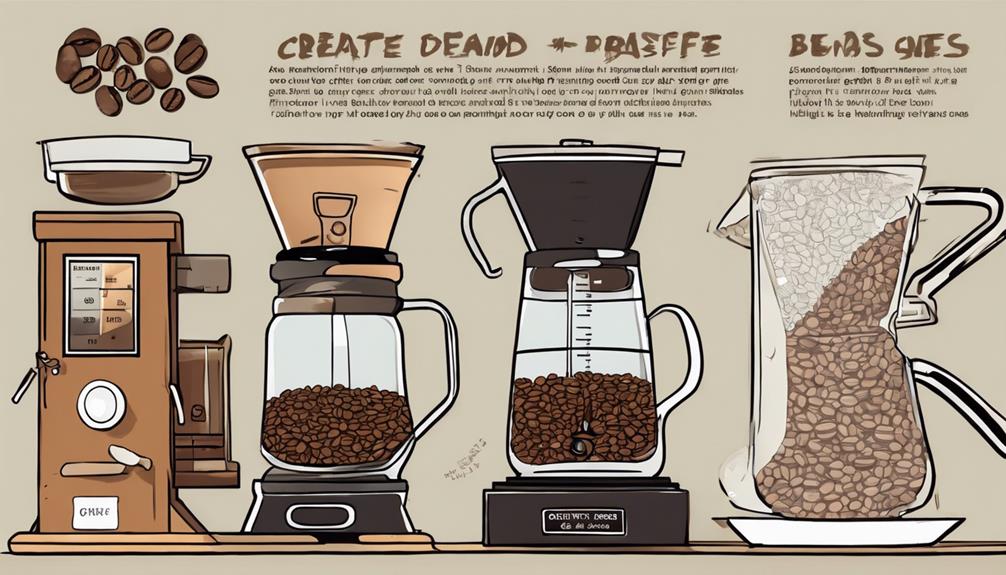
Consider various factors such as flavor profile, grind size, roast level, bean origin, and packaging when selecting the best ground coffee for your preferences. The flavor profile of coffee can vary greatly, from light roasts with fruity undertones to dark roasts boasting nutty or chocolatey notes.
Each element contributes to the overall experience of your cup of joe. Here are some key aspects to ponder:
- Roast Level: The roast level determines the flavor intensity and aroma of the coffee. Light roasts offer a more delicate taste, while dark roasts provide a bolder, smokier flavor.
- Flavor Profile: Different beans and roasts yield unique flavor profiles. Consider whether you prefer a bright and acidic brew or a richer, full-bodied cup.
- Bean Origin: The region where the coffee beans are grown impacts the taste. Explore beans from various origins to discover your favorite flavor profiles.
- Packaging: Opt for ground coffee stored in airtight, resealable bags to secure freshness and preserve the intricate flavors.
Tips for Selecting the Best Coffee

Discover these practical tips to assist you in selecting the finest ground coffee that complements your taste preferences and brewing needs. Consider the roast level to match your desired flavor intensity, whether it’s light, medium, or dark. Also, take into account the grind size, as it can affect the extraction process during brewing. Always read the packaging for information on the coffee’s origin and flavor notes. With these tips in mind, you’ll be able to make the best coffee picks to elevate your daily coffee experience.
When seeking the ideal cup of coffee, consider the flavor profile that suits you. If you prefer a well-rounded taste with subtle acidity and rich body, go for a medium roast.
Additionally, pay attention to the grind size, ensuring it aligns with your brewing method for excellent extraction. Explore the bean origin as well; single-origin coffees provide various flavors based on where the beans were grown.
Assess the packaging before buying, selecting airtight, resealable bags to maintain freshness and flavor. To truly discover your preferred blend, don't hesitate to experiment with different brands and flavors.
Exploring Coffee Preferences

Delving into the domain of coffee preferences reveals a diverse landscape of tastes and experiences shaped by individual palates and preferences. When exploring the sphere of coffee, consider the following:
- Arabica is considered: Known for its smooth and flavorful characteristics, Arabica beans are favored by those who appreciate nuanced and aromatic brews.
- French press: This brewing method allows for a rich and full-bodied coffee experience, appealing to individuals who enjoy the robust flavors extracted through immersion brewing.
- Light vs. Dark Roasts: Some coffee lovers lean towards the bright and acidic notes of light roasts, while others savor the deep and intense flavors found in dark roasts.
- Single-Origin vs. Blends: Single-origin coffees offer a glimpse into specific regions' terroir, enticing those seeking unique and distinctive flavor profiles, while coffee blends provide a harmonious balance suitable for those desiring consistency in every cup.
Understanding these preferences can guide you in discovering your ideal cup of coffee tailored to your taste preferences.
Frequently Asked Questions
How Do I Know What Coffee Grind Is Best?
You know what coffee grind is best by matching it to your brewing method. Espresso needs fine, French press prefers coarse. Consistent grind guarantees even extraction and balanced flavor. Experiment with grind sizes to find your perfect cup.
How Can You Tell if Coffee Grounds Are Good?
You can tell if coffee grounds are good by checking for a consistent grind size, a recent roast date, and a rich aroma. Avoid dull appearance or off smells. Quality grounds will brew a flavorful cup with distinct notes.
What Is the Best Coffee to Grounds Ratio?
For the best coffee to grounds ratio, aim for 1:15. Experiment with 1:17 for a lighter brew or 1:13 for a stronger one. Use a kitchen scale to guarantee accuracy. Consistency is key. Customize based on your taste preferences!
Does Fine or Coarse Ground Coffee Taste Better?
When it comes to taste, it's all about preference. Fine ground coffee offers a bold, intense flavor ideal for espresso. Coarse ground coffee provides a smoother, balanced taste perfect for French press or cold brew. Experiment to find your favorite!
Conclusion
So there you have it – when it comes to choosing the best ground coffee, freshness is key!
Remember, pre-ground coffee may be convenient, but nothing beats the flavor and aroma of freshly ground beans.
Just like a fine wine, coffee is meant to be savored and enjoyed at its best.
So treat yourself to the perfect cup of coffee by selecting the freshest and highest quality ground coffee for your morning pick-me-up!
